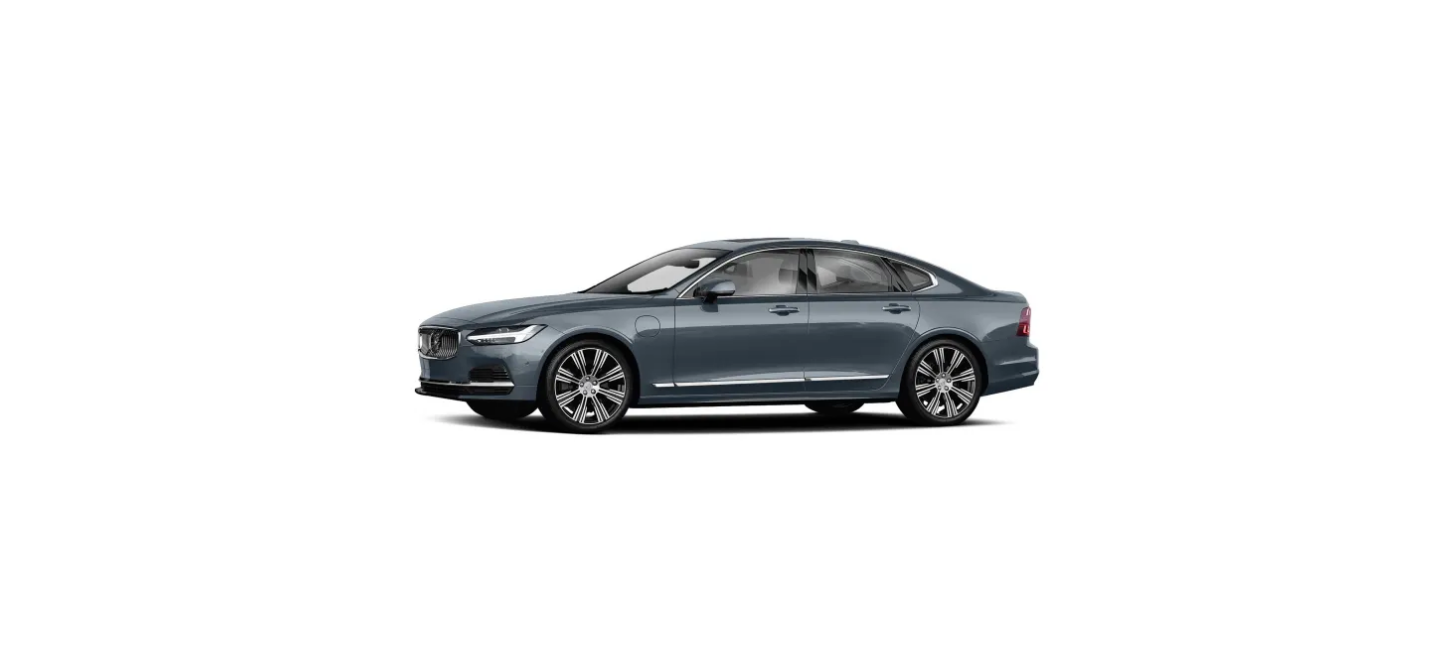2022 Volvo S90 Recharge Plug-in Hybrid Assistance at risk of collision
Assistance at risk of collision
The function is not available in all markets.
Assistance at risk of collision can assist the driver to avoid or mitigate a collision with a warning, automatic braking and steering assistance.
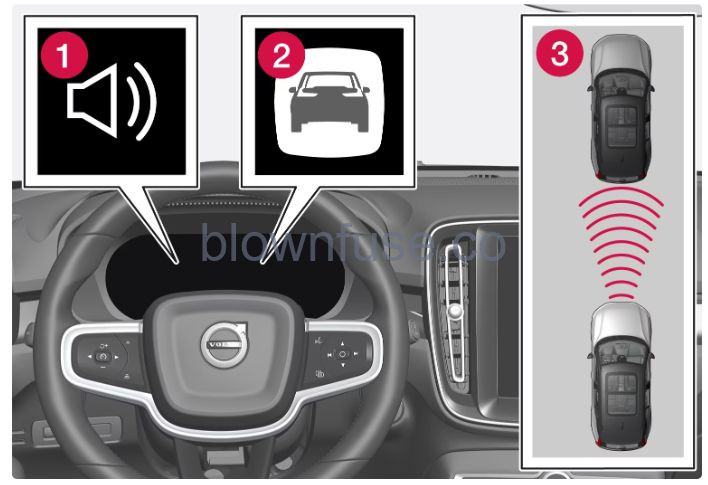
Audio and symbol for collision warning
- Acoustic signal in the event of a risk of collisio
- Warning signal in the event of a risk of collision
- Distance measurement with the camera and radar units
The driver or passengers are not normally aware of the function – it only intervenes in a situation where a collision is immediately imminent.
The function can help the driver to avoid a collision when driving in queues, e.g. when changes in the traffic ahead, combined with a lapse in attention, could lead to an incident. The function then activates a short, sharp braking procedure, normally stopping the car just behind the vehicle in front.
The function cannot be deactivated but is always activated.
Assistance at risk of collision can perform the following steps if necessary:
- Collision warning
- Assisted braking
- Automatic braking
- Steering assistance
The function is designed to be activated as late as possible in order to avoid unnecessary intervention. Automatic braking takes place only after or at the same time as the collision warning.
When brake assistance has prevented a collision with a stationary object, the car remains stationary in anticipation of positive action by the driver. If the car has been braked to avoid collision with a slower vehicle in front its speed is reduced to match that of the vehicle in front.
The driver can always interrupt a braking intervention by firmly depressing the accelerator pedal.
When the function is activated and brakes, the brake lights are switched on. The driver display shows a text message advising that the function is or has been active.
Warning
Note
It is always the driver who decides how much the car should steer – the car can never take command.
Warning
- The function is supplementary driver support intended to facilitate driving and make it safer – it cannot handle all situations in all traffic, weather and road conditions.
- The driver is advised to read all sections in the Owner’s Manual that relate to this function to learn about factors such as its limitations and what the driver should be aware of before using the system.
- Driver support functions are not a substitute for the driver’s attention and judgement. The driver is always responsible for ensuring the car is driven in a safe manner, at the appropriate speed, with an appropriate distance to other vehicles, and in accordance with current traffic rules and regulations.
Detection of obstacles with assistance at risk of collision
Assistance at risk of collision (Collision Avoidance) can help the driver to detect different types of obstacle.
The function can detect pedestrians, cyclists or vehicles that are stationary or moving in the same direction as the car and are ahead. The function can also detect pedestrians, cyclists or large animals that are crossing the road in front of the car.
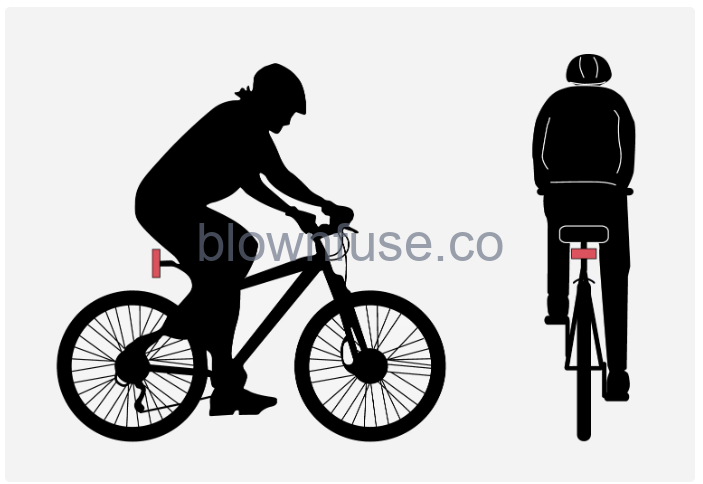
Examples of what the function interprets as a cyclist — with clear body outline and bicycle outline.
Good performance requires that the camera and radar units that detect a cyclist must receive the clearest possible information about the body and bicycle outline, requiring the ability to identify the bicycle, head, arms, shoulders, legs, upper and lower body plus a normal human pattern of movement.
If large parts of the cyclist’s body or bicycle are not visible to the function’s camera then the system cannot detect a cyclist.
For the function to be able to detect a cyclist, he/she must be an adult and riding a bicycle designed for adults.
- partially obscured cyclists.
- cyclists if the background contrast for the cyclists is poor.
- cyclists wearing clothing that obscures the body outline.
- bicycles loaded with large objects.
Pedestrians
Examples of what the function regards as pedestrians with clear body outlines.
Good performance requires that the camera and radar units that detect a pedestrian must receive the clearest possible information about the body outline, requiring the ability to identify the head, arms, shoulders, legs, upper and lower body plus a normal human pattern of movement.
In order that it shall be possible to detect a pedestrian there must be a contrast with the background and this will be affected by such things as clothes, the background and the weather. With poor contrast the pedestrian may either be detected late or not at all, which may mean that warnings and braking are late or omitted.
The function can also detect pedestrians in the dark if they are illuminated by the car’s headlamps.
- partially obscured pedestrians, people in clothing that hides their body contour or pedestrians shorter than 80 cm (32 tum).
- pedestrians if the background contrast for the pedestrians is poor.
- pedestrians who are carrying larger objects.
Large animals
Examples of what the function interprets as large animals – standing still or walking slowly and with clear body outline.
Good performance requires that the system function that detects a large animal (e.g. elk and horse) must receive the clearest possible information about the body outline, requiring the ability to identify the animal directly from the side in combination with what is a normal pattern of movement for the animal.
If parts of the animal’s body are not visible to the function’s camera then the system cannot detect the animal.
The function can also detect large animals in the dark if they are illuminated by the car’s headlamps.
- partially obscured large animals.
- larger animals seen from the front or from behind.
- large animals that run or move quickly.
- large animals if the background contrast for the animals is poor.
- small animals such as dogs and cats, for example.
Warnings and brake interventions could be late or not occur at all. The driver is always responsible that the vehicle is driven correctly and with a safety distance adapted to the speed.
Speed reduction option with assistance at risk of collision
Assistance at risk of collision ( Collision Avoidance) can help to prevent a collision or reduce the collision speed.
If the speed difference between the driver’s car and the obstacle is greater than the following specified speeds, the automatic brake function cannot prevent a collision but it can mitigate the consequences of a collision.
Symbols and messages for assistance at risk of collision
A number of symbols and messages regarding assistance at risk of collision (Collision Avoidance) can be shown in the driver display. Here are some examples.
| Symbol | Message | Specification |
|---|---|---|
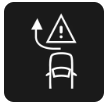 |
Automatic intervention Collision Avoidance
|
When the function is activated, a message is shown to the driver indicating that the system has been activated. |
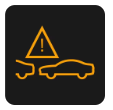 |
Collision Avoidance system unavailable | The system is temporarily out of order or is working with reduced performance. |
 |
Windscreen sensor blocked See Owner’s manual | The ability of the camera to scan the roadway in front of the car is reduced. |
A text message can be cleared by briefly pressing the ![]() button, located in the centre of the steering wheel’s right-hand keypad.
button, located in the centre of the steering wheel’s right-hand keypad.
If a message remains, contact a workshop – an authorised Volvo workshop is recommended.
Limitations for assistance at risk of collision
Assistance at risk of collision (Collision Avoidance) has certain limitations that a driver should be aware of.
- for small vehicles, such as motorcycles
- if the majority of the car has moved into the adjacent lane
- on roads/in lanes with unclear or non-existent lane markings
- outside the speed range 60-140 km/h (37-87 mph)
- as the steering servo for speed-dependent steering wheel resistance is working at reduced power – e.g. when cooling due to overheating.
Other demanding situations can include:
- road works
- winter road conditions
- narrow roads
- poor road surface
- a very “sporty” driving style
- poor weather with reduced visibility.
In these demanding situations, the function may have difficulty helping the driver correctly.
- Never wait for a warning or intervention. Apply the brakes when the situation requires.
- Automatic braking can prevent a collision or reduce collision speed, but to ensure full brake performance the driver should always depress the brake pedal – even when the car brakes automatically.
- The warning and steering assistance are only activated if there is a high risk of collision – you must therefore never wait for a collision warning or for the function to intervene.
- The function does not activate any automatic brake interventions in the event of heavy acceleration.
- Warnings and brake interventions could be implemented late or not at all if a traffic situation or external influences mean that the camera and radar units cannot detect pedestrians, cyclists, large animals or vehicles correctly.
- For vehicles to be detected at night, their headlamps and rear lamp cluster must be switched on and shining clearly.
- Warnings for stationary and slow-moving vehicles, as well as large animals, may be disengaged due to darkness or poor visibility.
- Warnings and brake interventions for pedestrians and cyclists are deactivated at vehicle speeds exceeding 80 km/h (50 mph).
- The system can provide effective warnings and brake interventions as long as the relative speed is below 50 km/h (30 mph).
- For stationary or slow-moving vehicles, warnings and brake interventions are effective at vehicle speeds up to 70 km/h (43 mph).
- Speed reduction for large animals is less than 15 km/h (9 mph) and can be achieved at vehicle speeds above 70 km/h (43 mph). The warning and brake intervention for large animals is less effective at lower speeds.
- Do not place, stick or mount anything on the outside or inside of the windscreen in front of or around the camera unit – this can interfere with camera-dependent functions.
- Objects, snow, ice or dirt in the area of the camera and radar units may reduce their functionality, fully deactivate them or give incorrect function response.
Assistance at risk of collision in crossing traffic
Assistance at risk of collision (Collision Avoidance) can assist the driver when turning and crossing the path of an oncoming vehicle at an intersection.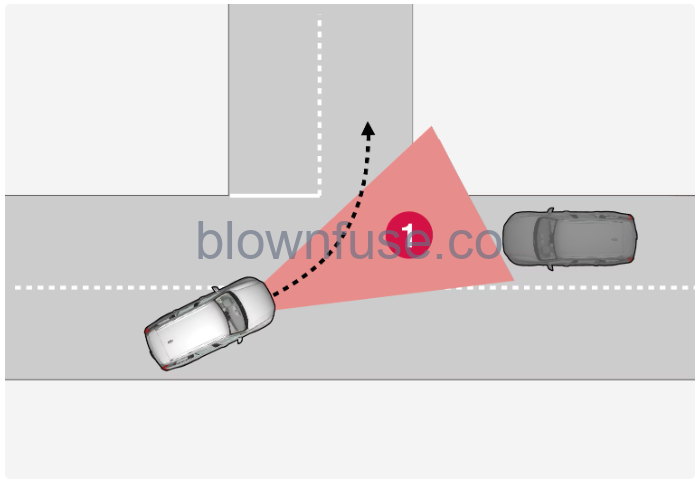
- Sector in which the function can detect oncoming crossing vehicles.
For the function to detect an oncoming vehicle on a collision course, the oncoming vehicle must first enter the sector in which the function can analyse the situation.
In addition:
- your car’s speed must be at least 4 km/h (3 mph).
- your car must turn to the left in markets with right-hand traffic (or to the right in left-hand traffic).
- the oncoming vehicle must have its headlamps switched on.
The function may have difficulty in assisting the driver if, for example:
- there are slippery driving conditions and stability control (Electronic Stability Control ESC) intervenes.
- an oncoming vehicle is detected too late.
- an oncoming vehicle is obscured by something.
- the oncoming vehicle has headlamps switched off.
- the oncoming vehicle drives in an unpredictable manner, for example, abruptly changes lanes at a late stage.
Assistance at risk of collision in oncoming traffic
Assistance at risk of collision (Collision Avoidance) can assist the driver to give steering assistance to avoid a collision with vehicles in the oncoming lane. The function can also reduce the speed of the car in order to reduce the force of an impact in the event of an encroachment into the car’s own lane.
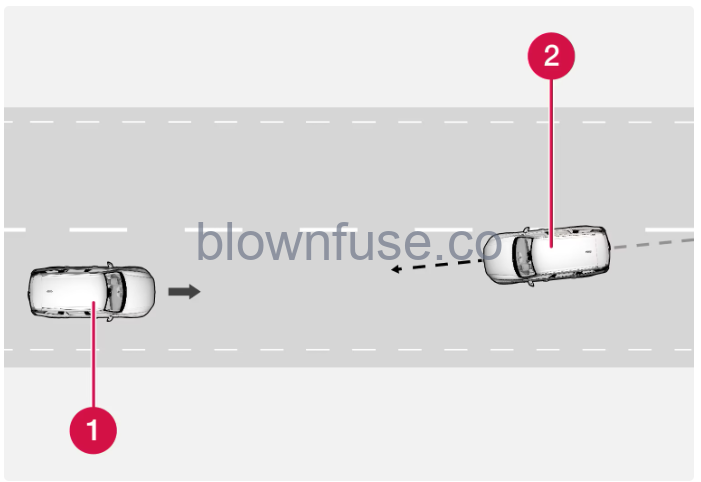
- Your car
- Oncoming vehicles
For this function to work, the following criteria must be met:
- your car must be travelling at more than 4 km/h (3 mph)
- the road section must be straight
- your car’s lane must have clear lane markings
- your car must be positioned straight in its own lane
- the oncoming vehicle must be within your car’s lane markings
- the oncoming vehicle must have its headlamps switched on
- this function can only handle “front to front” collisions
- this function can only detect vehicles with four wheels.
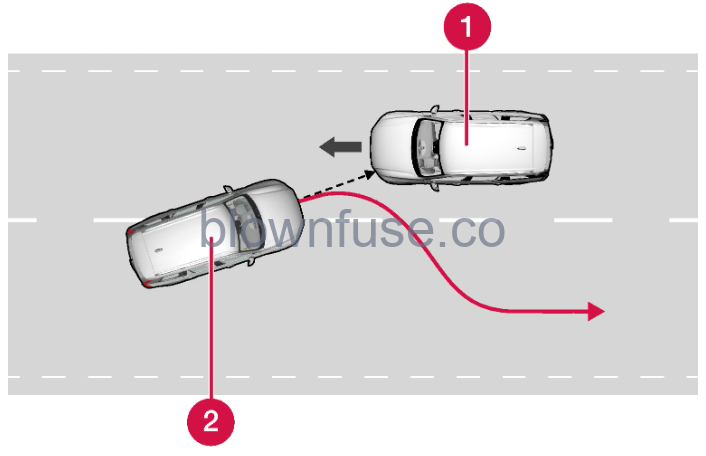
The function can assist by guiding the car back to its own lane.
- Oncoming vehicles
- Your car
The function is active within the speed range 60-140 km/h (37-87 mph) on roads with clearly visible lane markings/lines.
If the car is about to leave its own lane while an oncoming vehicle is approaching at the same time, the function can help the driver to steer the car back into its own lane.
However, the function does not intervene with steering assistance if the direction indicator is used. If the function detects that the driver is actively driving the car, activation of the function will be delayed.
When the function intervenes, a symbol and a message are shown in the driver display, and an acoustic signal can be heard as well.
Assistance at risk of rear-end collision
Assistance at risk of collision (Collision Avoidance) can help a driver who does not notice that the car is about to leave its own lane while an oncoming vehicle is approaching at the same time, either from behind or in the blind spot.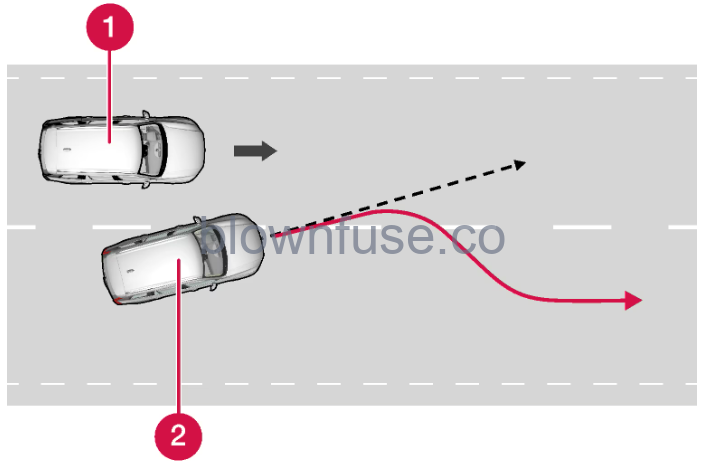
The function can assist by steering the car back to its own lane.
- Other vehicle in the blind spot
- Your car
The function can even assist if the driver intentionally changes lanes using direction indicators without noticing that another vehicle is approaching.
The function is active within the speed range 60-140 km/h (37-87 mph) on roads with clearly visible lane markings/lines.
The lamps in the door mirrors flash during steering intervention, regardless of whether BLIS (Option/accessory.) (Blind Spot Information) is activated. An acoustic signal can also be heard.
When the function intervenes, a message is shown in the driver display.
Assistance at risk of run-off
Assistance at risk of collision (Collision Avoidance) can help the driver and reduce the risk of the car accidentally leaving the road by actively steering the car back onto the road.
The function has two levels for intervention:
- Steering assistance only
- Steering assistance with brake intervention
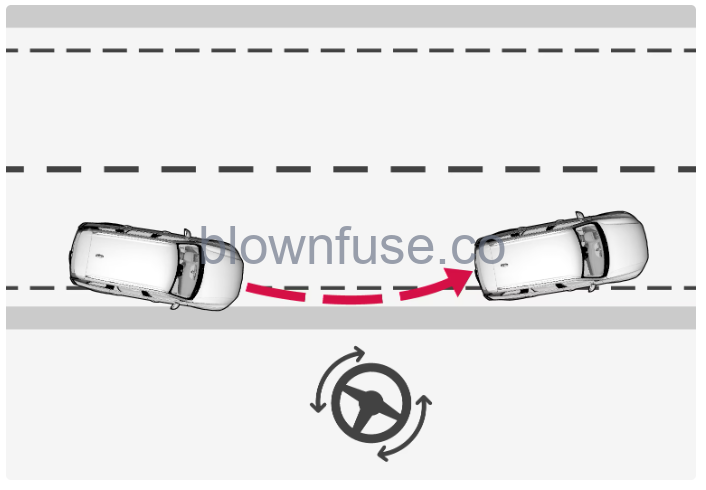
Intervention with steering assistance
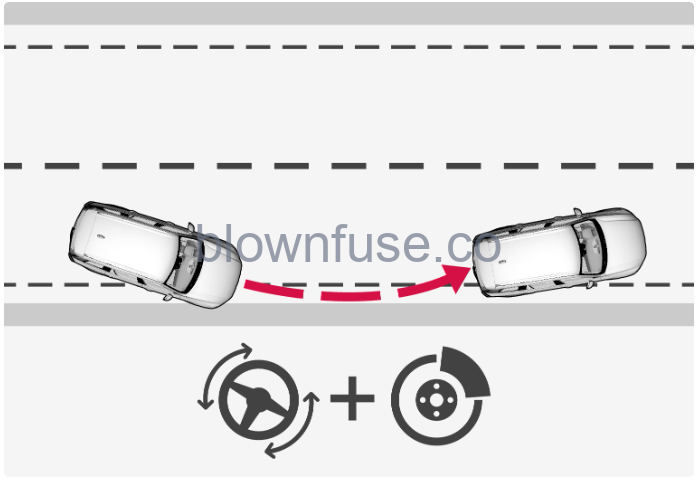
Intervention with steering assistance and braking
Brake intervention helps in situations where steering assistance alone is not sufficient. The brake force is adapted automatically depending on the situation at the time of road run-off.
The function is active within the speed range 65-140 km/h (40-87 mph) on roads with clearly visible lane markings/lines.
The car’s camera unit scans the edges of the road and the painted lane markings. If the car is about to leave the side of the road, the car is steered back onto the road and if the steering intervention is not enough to avoid run-off, the brakes are also activated.
However, there is no intervention from the function with either steering assistance or brake intervention if the direction indicators are used. If the function detects that the driver is actively driving the car, activation of the function will be delayed.
When the function intervenes, a message is shown in the driver display.
